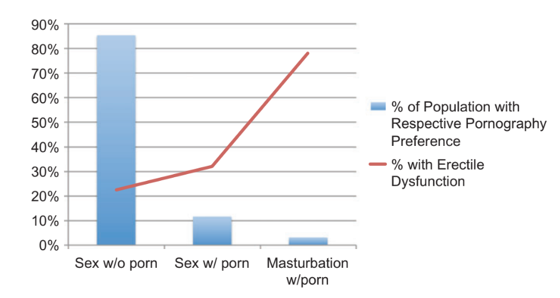A recent study published in the Military Medicine journal looked at the relationship between sexual dysfunction and pornography use, and showed several key findings. There is a growing body of research on pornography as a public health crisis. Based on academic literature on pornography induced erectile dysfunction (PIED) as well as the increasing acceptance and normalization of pornography by society, the researchers believed they would find a correlation between sexual dysfunction and pornography use among the men and women surveyed.
Over 500 surveys were distributed to men and women aged 20-40 at a Naval urology clinic in San Diego. To assess sexual dysfunction, researchers used the International Index of Erectile Function (IIEF) as well as the Female Sexual Function Index (FSFI). Pornography use was measured based on frequency, duration, and modality. They also asked questions using a pornography cravings questionnaire and an obsessive passion scale, in an attempt to gather data on potential addiction. Preferences of the men and women were measured by the choice between partnered sex or masturbation.
The data was skewed toward more male responses, likely due to the demographics of the military. Men significantly reported more pornography use, at 81.1% of respondents saying at least “some use” compared to 39% of women respondents. 9.3% of men reported daily use of pornography. The majority of respondents, both men and women, primarily viewed pornography through the Internet. Based on the scales used, 32.4% of male respondents and 52% of females were identified with sexual dysfunction.
Right away, we can see that there are large quantities of people regularly using pornography, and also a significant amount of people with reported sexual dysfunction. While that alone cannot prove a link between them, the study also found that “rates of erectile dysfunction were lowest in men who preferred partnered sex without pornography (22.3%) but increased significantly when masturbation to pornography was preferred over partnered sex (78%)”.

What’s more, this problem doesn’t seem to be going away. With pornography usage ever rising, it seems society is determined to let pornographers and exploiters to win, selling young men and women the false message that pornography is completely safe and normal. Studies are showing pornography use, especially through the Internet, is consistently higher among younger populations. Rates of exposure to pornography before the age of 13 have skyrocketed in recent years, at around 50%. With pornography serving as the main sexual education for so many, it seems issues such as sexual dysfunction may be rising as well.
Proving causation between pornography and sexual dysfunction was outside the scope of this study, however the researchers acknowledge the significant link between the two. They recommended several variables that should be explored in further research including adolescent exposure, volume of pornography being used, and the genre of the porn itself. It is noted that ED rates for those who used pornography on a daily basis were double than those who were considered “casual” viewers, at 44% versus 22%. We know from additional research that compulsive or hyper usage of pornography plays a significant role in health problems like sexual function. And with the genre of pornography becoming increasingly filled with violent and degrading themes such as rape and incest, it’s incredibly important to consider these factors in how they affect the health of the mind and body, as well as society at large.
Learn more about the public health harms of pornography here. More research resources here.





